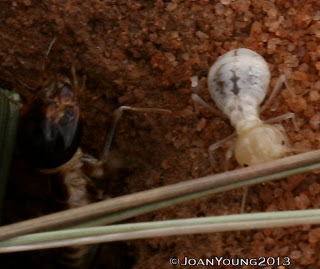This was AMAZING!! Awesome!! Fantastic!! To see the video, please go to: http://youtu.be/RHIMO5iSAc8
This morning on my way out of camp, I turned a corner and came across a Greyheaded Bush Shrike attacking a Southern Vine Snake. These birds don’t normally go for something this big and why the snake (which has toxic venom) did not bite him, I do not know!! The snake puffed up his head and tried to go in the opposite direction, heading for the nearby bushes, but the bird kept on biting him on the head and neck, trying to get a good grip in order to pull him back to the road........
The bush the snake went into has an aloe growing in the middle with very broad leaves and thorny spines. The bird went from one side of the bush to the other trying to get at the snake but at most, a pull on its tail was the most it could do and nothing dislodged the snake from its hideout.
After about 10 minutes, the bird gave up and flew off. Although I waited around and peered into the bush for a while, the snake did not come out so I left too.
If you like the video, please share the link to it. Thanks.

a.jpg)
a.jpg)
a.jpg)
a.jpg)
a.jpg)
a.jpg)
a.jpg)









































